

Australians with rooftop solar panels could soon be charged for exporting power into the grid, under proposed changes. Switching off rooftop solar will become an important feature of a renewables grid. Mobile.reuters. Sonnen Launches Lower-Priced Battery for Home Backup and Grid Services. After years of selling more expensive home battery systems, sonnen launched a new product Thursday to compete on cost with other mainstream options in the U.S. residential energy storage market.
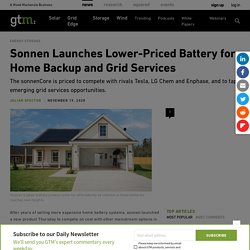
The Germany-based company, acquired by oil major Shell in 2019, designed its sonnenCore system to deliver daily cycling for grid services as well as backup power. It comes with a capacity of 5 kilowatts/10 kilowatt-hours and a price point of $9,500. That puts it in competition with the similarly sized and priced LG Chem Resu and Enphase Encharge batteries; it's slightly smaller than Tesla's Powerwall, which holds 13.5 kWh. The sonnenCore marks an evolution in sonnen's strategy. As other providers raced to match Tesla's low price, sonnen went up-market with the ecoLinx, launched in 2018 to appeal to the luxury-home-automation crowd. Learning from the luxury market. Massive $5 million solar power system pays off for Australia's largest free-range chicken farm - ABC News.
The country's biggest free-range meat chicken farm has slashed its power bill after installing one of agriculture's most extensive solar and battery systems.
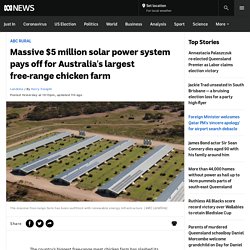
Key points: A large-scale free-range meat chicken farm has invested in extensive solar and battery systemsIt is also turning straw and manure from chicken sheds into profitable compostThe investment group that owns the farm believes the sustainable model can be rolled out to all areas of agriculture "Before we put the system in, our cost of energy imported from the network was getting towards $1 million," said Ben Edser from AAM, the investment group that owns Riverlands Free Range. Storage proponent for huge Broken Hill micro-grid fails to land finance for pilot plant. A world-leading storage plan for the mining city of Broken Hill – designed to create one of the world’s biggest renewable energy micro-grids – has been put under question because the technology provider has so far failed to get finance for a pilot project in South Australia, and has also laid off its sole Australian employee.
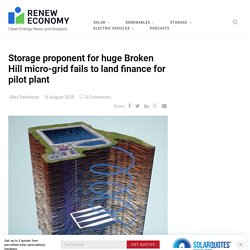
Hydrostor’s compressed air energy storage (CAES) technology was announced on Wednesday by transmission company Transgrid as its favoured option to replace ageing gas turbines that currently supply the emergency back-up in Broken Hill. It’s the largest CAES project of its type in the world. Hydrostor in early 2019 was announced as a winner of $9 million in federal and state funding for a 5MW/10MWh pilot and demonstration project of its technology at the mothballed Angas zinc mine in South Australia. Last September, Hydrostor announced it had landed $US37 million (then $A55 million) in funding but much of that money was destined for projects and operations elsewhere.
Generac, the Backup Generator Giant, Launches Souped-Up Home Solar-Storage System. Solar-battery systems may be useful for providing backup power during power outages.
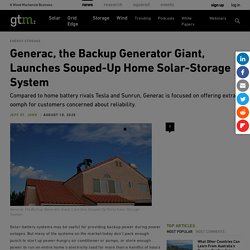
But many of the systems on the market today don’t pack enough punch to start up power-hungry air conditioner or pumps, or store enough power to run an entire home’s electricity load for more than a handful of hours at a time. That’s how Generac Power Systems sees it, at least. Since its entry into the solar-storage market last fall, the U.S. natural-gas backup generator giant has focused on systems with extra oomph, compared to competitors Tesla, Sunrun and LG Chem. While that extra power and capacity has come at a higher cost, Generac has been dropping prices to match competing systems in recent months, analysts say. Managing backup power at the circuit level. How to Wire Solar Panels in Parallel & Batteries in Series? While most of the domestic PV panels installation are in 12VDC systems, there are cases where we need 24V or additionally 36V, 48 and so on depending on the system requirements.
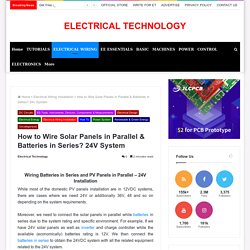
Moreover, we need to connect the solar panels in parallel while batteries in series due to the system rating and specific environment. For example, If we have 24V solar panels as well as inverter and charge controller while the available (economically) batteries rating is 12V. We then connect the batteries in series to obtain the 24VDC system with all the related equipment related to the 24V system. In this scenario, we will have to connect the 24V PV panels in parallel while connecting the 12V batteries in series. What’s Holding Geothermal Energy Back? It’s abundant, and it’s emissions-free: the heat from the earth’s mantle that reaches well into the crust and gives deep drillers a headache occasionally is the new star on the renewables block.

Nevertheless, oil and gas companies have been somewhat reluctant to embrace it. Let’s first clarify: geothermal energy is only “new” in terms of the media attention it has been getting. Researchers - including people from the oil and gas industry - have been working for decades on technologies to extract the heat from the earth and either use it directly or turn it into electricity. It is only gaining prominence now as these technologies advance and the world’s attention becomes increasingly focused on alternatives to fossil fuels. For the oil industry, geothermal is the alternative that, from a certain perspective, makes the most sense. Adam Danyal on LinkedIn: #techthatmatters #solarenergy #solarpower.
Nine more solar farms could have output cut to zero due to system strength issues. Another nine large-scale solar farms in north Queensland with a total capacity of more than 712MW have been warned that their output could be cut to zero in certain circumstances due to emerging “system strength” issues in that part of the state.
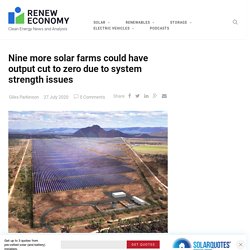
The warning was made in a market notice issued by the Australian Energy Market Operator on Monday and comes on top of a previous warning that affected two solar farms and one wind farm earlier this year. The latest to be affected are the Clare (110MW), Collinsville (42MW), Daydream (80MW), Hamilton (58MW), Hayman (58MW), Kidston (50MW), Ross River (128MW), Rugby Run (128MW), and Whitsunday (58MW) generators. They have been told that their output could be restricted to zero if certain combinations of synchronous generators (coal, gas or hydro) are not operating at the time. A Plug-and-Play Microgrid for Rooftop Solar. A few years ago, I found myself in the laundry room of a house in Austin, Texas, looking at some disturbing electrical signals on an oscilloscope.
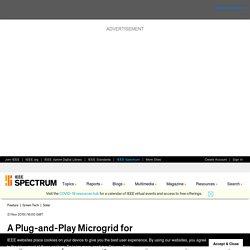
In my capacity as chief technology officer for the nonprofit clean-energy-research firm Pecan Street, examining the effect on the grid of homes with rooftop photovoltaics is my job. But what I was seeing that day in the house’s connection to the grid sparked an idea. “If I added energy storage to this house, I could fix this,” I remember saying.
A guide to community microgrids - Solar Choice. CarbonTRACK Community microgrids are a way for neighbourhoods, villages, towns and cities to meet their energy needs locally.

Increasingly, community microgrids are being eyed as an option even in areas where a larger grid already exists, mainly as a way to increase local energy independence and resilience. This article covers community microgrid basics, from the reasons for their growing popularity to their components and applications – as well as an overview of how to join one. Background: Why community microgrids are a hot topic In order to understand why microgrids are gaining popularity, it’s helpful to understand how larger electricity grids (‘macrogrids’) operate – and the forces that are currently at play in changing them. The rise of distributed generators in the ‘macro’ grid A conventional electricity network (AKA ‘the grid’) is essentially comprised of three things: Low Cost Perovskite Solar Cells Breathing Down The Neck Of Fossil Gas. Clean Power Published on July 16th, 2020 | by Tina Casey July 16th, 2020 by Tina Casey Solar cells weighed in at an eye-popping $300 per watt when they first popped on the scene back in 1956.

Who woulda thunk those pricey baubles would some day drop into the single digits and chase mighty king coal out of the energy generation market? Microgrids - ENM Solutions. We lost our house in summer bushfires. Now we're going underground and off the grid. We lost our house and just about everything in it during the horrific fire season of 2019/20. Ours had the dubious distinction of being one of the very first houses to be lost on that terrible day that ushered in the Black Summer, and which brought with it scenes that would appall a nation – indeed the world – who had seen fires regularly and thought themselves accustomed to such phenomena. It was a beautiful house in a spectacular rural location, at the bottom of a valley, beside a creek that had never stopped running in any of the locals’ memory, and in a semi-rainforest habitat that was thought to be immune – or at least resistant – to fire.
The creek stopped several months before the fires raged, and the habitat proved to be anything but resistant to the conflagration. Much of it will not grow back in our lifetime, if ever. It may have been a beautiful house, but it had its shortcomings – especially in light of our growing awareness of, and push towards sustainability.
Solar flow battery breakthrough combines PV generation and storage in one device. A US-led research collaboration including a team of PV scientists from Australia has produced an ultra-efficient and long-lasting solar flow battery – a way to generate, store and re-deliver renewable electricity from the sun in one device. Chemists from the Song Jin lab at the University of Wisconsin-Madison said on Tuesday that the new device was made of silicon solar cells combined with advanced solar materials and integrated with optimally designed chemical storage components. Essentially, they combine the advantages of photovoltaic cells that convert sunlight into electricity with the advantages of flow batteries, which use tanks of chemicals that can react to produce electricity and be recharged by the solar cells.
The work was done in collaboration with researchers from the University of New South Wales and the University of Sydney in Australia, Utah State University, King Abdullah University of Science and Technology in Saudi Arabia and the City University of Hong Kong. Printed solar panels a shining light for saving energy. The University of Newcastle Centre of Organic Electronics developed proprietary technology using organic polymers that capture solar energy and conduct electricity. Liquid organic polymers are laid onto sheets of material by everyday printers, like ink on paper, to create a solar panel just 0.075 millimetres thick that can be stuck, with special adhesive tape, to a range of surfaces. Traditional rooftop photovoltaic solar panels use silicon to conduct electricity.
Professor Paul Dastoor from the University of Newcastle talks about the first public display of printed solar panels at Lane Cove. The first demonstration project for printed solar is powering a light display in Lane Cove town centre on Sydney's north shore, with panels stuck on the roof of a covered walkway powering the entire set-up. "Imagine a world where everyone has access to electricity, and where every surface can generate clean, low cost, sustainable energy from the sun," Professor Dastoor said. Solar developers downsize to dodge complex and costly connection rules. Developers of utility-scale solar farms are now looking to downsize their proposed solar projects in order to dodge the increasingly complex and costly connection requirements imposed by Australian regulators.
Solar projects of 5MW or under can be popular for a variety of reasons – they are within the financial reach of local councils looking for a renewable energy supply, can deliver to local businesses and can fit into a relatively small area. They have become the flavour of the month in states such as South Australia, where Flow Power is building several to service the needs of corporate customers like S.A. Water and the City of Adelaide. It is often said that bigger projects offer bigger savings through scale and can deliver lower cost power, but small projects in Australia are also not subject to the same tough regulations that have afflicted, and caused lengthy delays, and added costs to many larger scale solar (and wind) projects. Tech That Matters on LinkedIn: #techthatmatters #solarenergy #technology.
The Sense Solar Home Energy Monitor Is Like An X-Ray For Your Home Electrical System — CleanTechnica Review. Buildings. Eco-Friendly "Wood" Stove Can Power a Small House, Using Garbage for Fuel. A new highly efficient “wood” stove generates electricity while cooking your food and heating your house… AND it runs on virtually any biomass, reducing deforestation The InStove is built around a large cook pot. It can burn wood, pellets and almost any other biomass fuel including crop wastes, dung, waste paper, and other garbage. Unforgettable Fire™ Wood Stoves. TEGmart - Thermoelectric Generator Products. Thermoelectric Stoves: Ditch the Solar Panels? Double sided solar panels have arrived and they’re 35% more effective. Double sided solar panels which collect light on both sides and move to follow the sun’s position produce over a third more energy than standard systems. Most solar panels installed around the world are fixed in one position, without the ability to adapt to where the sun is in the sky.
Therefore, research has previously been focused on how to make these systems more efficient instead of looking at how the electricity produced could be increased in other ways. Gupta solar farm to employ innovative construction method to save ‘bonsai forest’ The Lead A new technique to preserve native vegetation and reduce dust is being rolled out during construction of the Cultana solar farm in South Australia. Cleaner, and now cheaper: Solar power beats coal. NSW paves way for more – and bigger – rooftop solar systems.
The New South Wales government has unveiled further relaxations to laws governing renewable energy development, paving the way for the installation of larger residential and commercial rooftop solar systems across the state. The new amendments to the State Environmental Planning Policy (Infrastructure) 2007, announced on Friday, will also allow utility providers to build electricity storage as part of improvement works to transmission and distribution networks. The changes follow an amendment published earlier this week to allow for stand-alone battery storage systems, a move that it expected to pave the way for multiple big batteries that no longer have to be co-located with a wind or solar farm, or other generator. The key beneficiaries of the latest amendments, however, will be households and business, with the changes allowing larger-scale solar systems to be installed on homes and commercial buildings without council approval.
NSW amends planning laws to pave way for stand alone big battery projects. The change – recorded as the State Environmental Planning Policy (Infrastructure) Amendment (Energy Storage Technology) 2020 under the Environmental Planning and Assessment Act 1979 – is simple enough, adding the words “electricity storage” to the allowable development applications. Previously, the act had restricted the allowable developments to just “making or generating electricity.”
Scientists develop a better redox flow battery. USC scientists have developed a new battery that could solve the electricity storage problem constraining widespread use of renewable energy. The technology is a new spin on a known design that stores electricity in solutions, sorts the electrons and releases power when it's needed. Unique technology surpasses conventional heat storage options in flexibility and efficiency. Hybrid Solar and Energy Storage Plants Are Growing Rapidly, But Are They a Good Idea? Lithium ion batteries: Here's what's coming to replace them. Solar windows made of chromophores. Now Would Be A Good Time To Appreciate Solar Power, Amirite? The Next Big Solar Technology? #Intersolar2020. Kyocera And 24M Introduce SemiSolid Lithium-Ion Residential ESS. Technological Breakthrough Achieved for Solar Cells – Previously Thought Impossible. Scientists discover three new species of solar power plants in 2019.
The Not-So-Secret Component In Next-Gen Solar Cells. The rise of solar power is jeopardising the WA energy grid, and it's a lesson for all of Australia. What is agrivoltaics? How can solar energy and agriculture work together? Energy Efficiency Soloar Farm Design Consultant. Solar power. Solar Farms: What Are They and How Much Do They Cost? Geothermal Energy Information and Facts. Bill Gates-Funded Startup Unveils “Holy Grail” of Solar Energy. Huge Tesla battery in South Australia primed for big upgrade. A banner year for advancing non-battery storage. OffGrid Power - Solar, Wind and Hybrid Systems in Australia.
Off Grid Solar Power System Prices, Solar System Installation Cost - OFF GRID SOLAR KITS. Meet the Aussie startup delivering solar minigrids to remote communities from a ping-pong table. Pole positions: why big companies are finding new ways to get off the grid. Solar Windows: Transforming Buildings Into Energy Producers. DIY Solutions For Solar Power Diversion Through Home Automation. New-tech-could-turn-windows-into-solar-panels-20171027-gz9goq. Onestepoffthegrid.com. Designing a 'solar tarp,' a foldable, packable way to generate power from sun. DNV-GL's 2018 Scorecard Results: Discover Which Panels Passed. Five ways the NEG works against consumers, and solar. Nocookies. SonnenFlat: Is the 'free energy' / single rate plan worth it? - Solar Choice. Nocookies. The Australian Home Battery Storage Buying Guide.
Water, water everywhere … even in the air. Tech start-up empowering better energy use. Elon Musk’s solar tiles have an infinite warranty, low cost. Tesla announced new low-profile rooftop solar panels for existing homes that it will manufacture with Panasonic — Quartz. Nexergy: Would you buy solar power from your neighbour? The virtual power plant. What Business Model Will Succeed in Energy Storage? Mobile solar to take on diesel power. Solar Incentive hits $5,168! ...But for how long? Origin launch first solar battery offering with the Tesla Powerwall - Origin Energy. Origin Introduces Low Solar Energy Rates for Business - Origin Energy. Powerwall in Australia: First residential installation of Tesla’s new product complete.
Batteries Included. Changes To Solar Legislation. New technology encourages landlords to embrace solar power. Batteries Included. The Southern Hemisphere's Largest Solar Plant. Tyalgum Energy Project could make NSW town 100 per cent sustainable. Batteries Included. How battery-powered homes are unplugging Australia. New Samsung Breakthrough Could Nearly Double Battery Capacity.
Cost of household solar has outweighed benefits: Grattan Institute report. Solar panels: the tech and the tariffs. Why Tesla's new battery is kind of a big deal. What the Tesla Powerwall battery means for households. Tesla announces new batteries for your home. The most common questions we've been getting recently at SolarQuotes. If electricity privatisation is troubling you, you can always get off the grid. Distributed Energy Storage System (DESS) - Solar AustraliaSolar Australia.